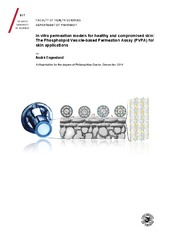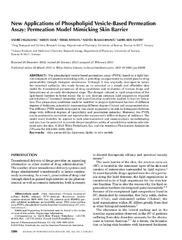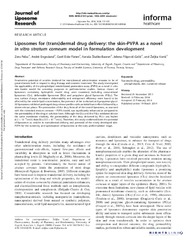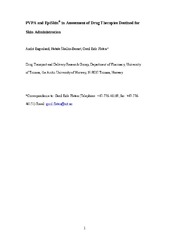| dc.contributor.advisor | Flaten, Gøril Eide | |
| dc.contributor.author | Engesland, André | |
| dc.date.accessioned | 2016-03-29T13:06:20Z | |
| dc.date.available | 2016-03-29T13:06:20Z | |
| dc.date.issued | 2015-03-20 | |
| dc.description.abstract | In vitro models with the ability to estimate drug penetration through healthy and compromised skin may reduce animal testing of drugs and cosmetics to a minimum. The phospholipid vesicle based permeation assay (PVPA) is based on a tight barrier composed of liposomes mimicking cells. It was originally made to mimic the intestinal epithelial barrier and in this project further developed to mimic the stratum corneum barrier of the skin. The lipid composition was changed to better mimic the lipid composition of skin and new preparation methods of the barriers were developed.
The performance of two new skin mimicking PVPA models was evaluated by assessing the permeation of eight drugs. The two models developed in this study
the PVPAs (E-80/ceramide/cholesterol/palmitic acid/cholesteryl sulphate) and PVPAc (E-80/cholesterol) appeared to distinguish between drugs of high and low penetration potential when compared with permeation data from animal skin and the reconstructed human skin, EpiSkin® as well as calculated data.
Moreover, the PVPA models mimicking skin were also applied to evaluate the penetration potential of a drug in different liposomal formulations. The permeation of drugs from liposomal formulations was significantly enhanced as compared to the drugs in solution form and was able to distinguish between carriers with different physicochemical properties. Encouraged by the results from previous experiments, different drugs and drugs in liposomal formulations were tested in the PVPAs and PVPAc models and the permeability results were compared with the results for the reconstructed human skin model, EpiSkin®. The results were in accordance with what was expected considering the physicochemical properties.
Finally, PVPA barriers mimicking a compromised skin barrier (accompanying skin disorders or skin damage) were developed. Two approaches were applied to prepare barriers with lower barrier function. First, by adjusting the concentration of ethanol used to fuse liposomes, thus controlling the tightness; second, reducing the thickness of the liposome layer. Results from the PVPA models demonstrated reliable increased permeation with the increased ethanol content and the decreased barrier thickness. | en_US |
| dc.description.doctoraltype | ph.d. | en_US |
| dc.description.popularabstract | Avhandlingen tar for seg utviklingen av en modell som kan forutsi hvordan stoffer går gjennom huden og testing av modellen mot dyrehud og menneskehud dyrket frem i et laboratorie. Modellen er en presis og svært reproduserbar metode for å estimere hvordan stoffer går gjennom huden både for enkle og avanserte systemer. Samtidig kan den tilpasses slik at den kan forutsi hvordan stoffer går gjennom en hudbarriere som er delvis skadet. Modellen er bygget opp av fettbobler som legges i lag på et filter og ligner hudens barriere i form og innhold. I tillegg så kan modellen brukes til å undersøke helt spesielle effekter for nanobærere av legemidler. Modellen har et stort anvendelsesområde både i farmasøytisk og kosmetisk industri hvor den kan bidra til å redusere og erstatte mange innledende dyreforsøk. | en_US |
| dc.description.sponsorship | I would like to thank the Norwegian Animal Protection Fund for their financial support. | en_US |
| dc.description | Paper IV of this thesis is not available in Munin:<br>Engesland André ... et al. : "Phospholipid vesicle-based permeation assay (PVPA) as in vitro models for the compromised skin barrier" (Manuscript). Revised published version with title "In vitro models to estimate drug penetration through the compromised stratum corneum barrier" available in <a href=https://doi.org/10.3109/03639045.2016.1171334>Drug Development and Industrial Pharmacy</a>, Vol. 42, No. 11, p. 1742–1751 (2016) | en_US |
| dc.identifier.uri | https://hdl.handle.net/10037/9065 | |
| dc.identifier.urn | URN:NBN:no-uit_munin_8621 | |
| dc.language.iso | eng | en_US |
| dc.publisher | UiT Norges arktiske universitet | en_US |
| dc.publisher | UiT The Arctic University of Norway | en_US |
| dc.rights.accessRights | openAccess | |
| dc.rights.holder | Copyright 2015 The Author(s) | |
| dc.rights.uri | https://creativecommons.org/licenses/by-nc-sa/3.0 | en_US |
| dc.rights | Attribution-NonCommercial-ShareAlike 3.0 Unported (CC BY-NC-SA 3.0) | en_US |
| dc.subject | VDP::Medical disciplines: 700::Health sciences: 800::Other health science disciplines: 829 | en_US |
| dc.subject | VDP::Medisinske Fag: 700::Helsefag: 800::Andre helsefag: 829 | en_US |
| dc.title | In vitro permeation models for healthy and compromised skin: The Phospholipid Vesicle-based Permeation Assay (PVPA) for skin applications | en_US |
| dc.type | Doctoral thesis | en_US |
| dc.type | Doktorgradsavhandling | en_US |


 English
English norsk
norsk



